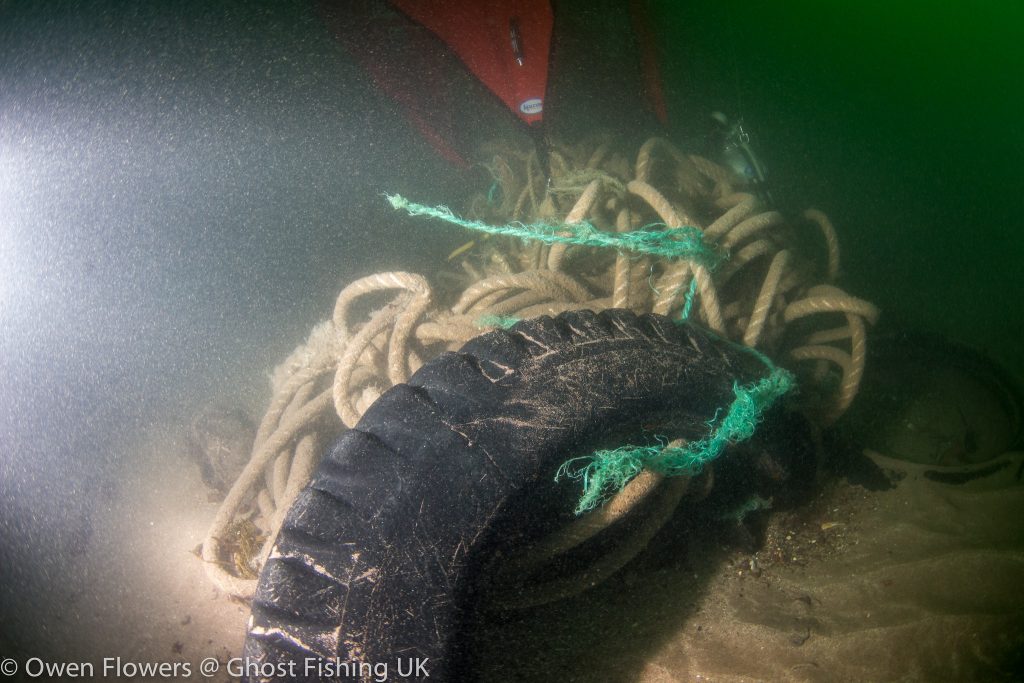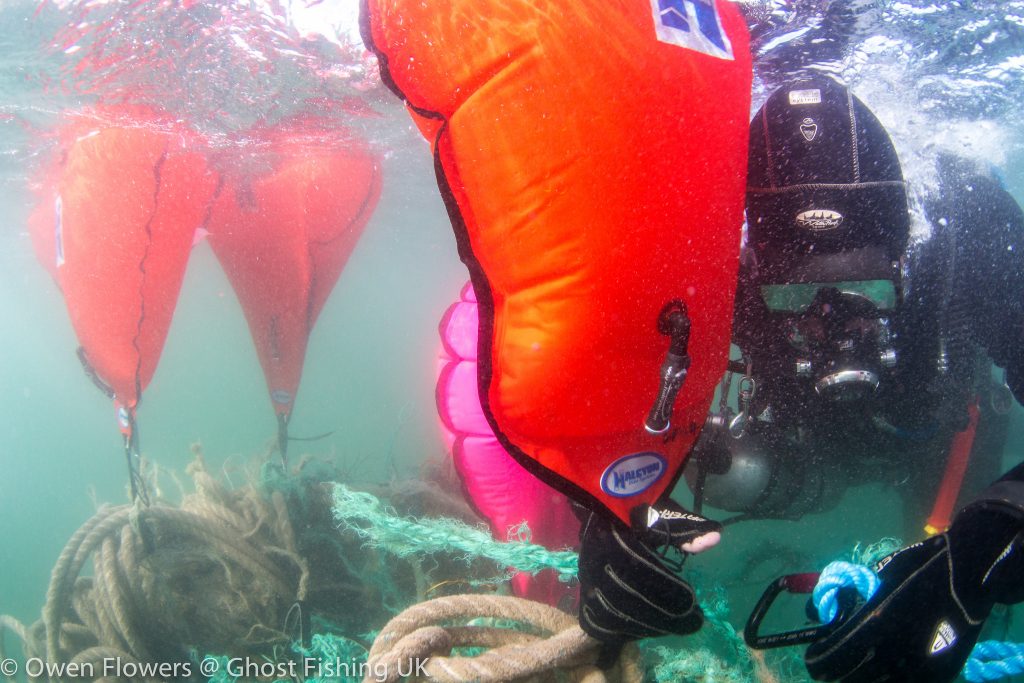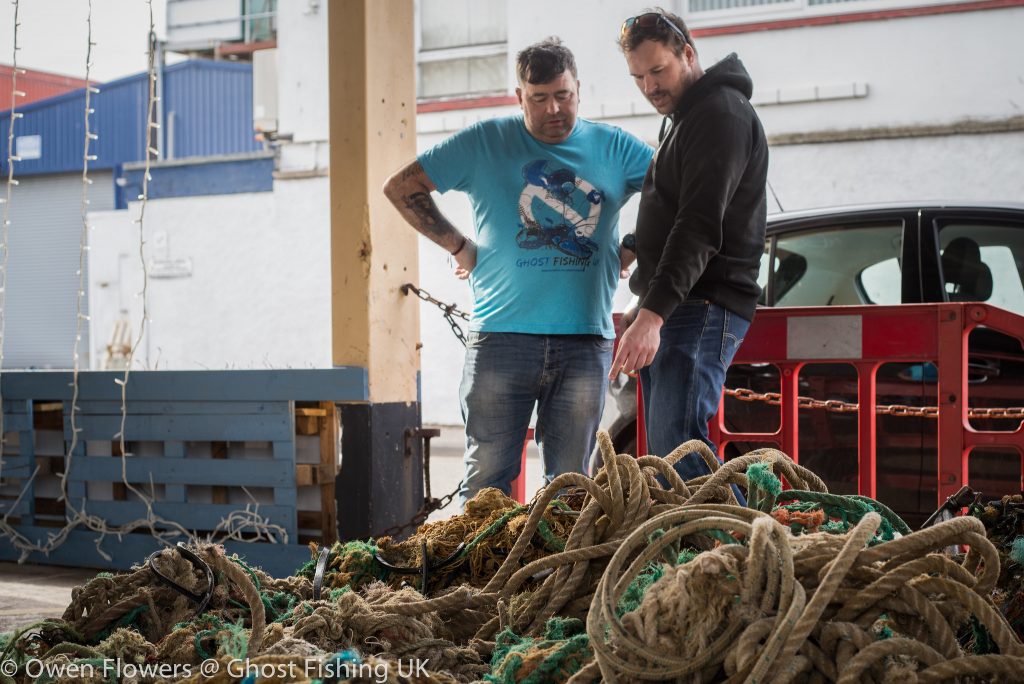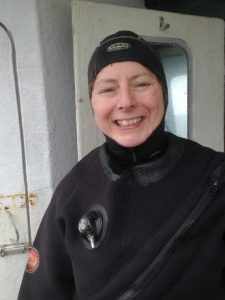Eyemouth 2019. Video: Owen Flowers
The weather had been calm and sunny the week before our trip on the Oceanic, recalls diver Sharon Brown. A member of my club was looking for a buddy and I always love a nice easy east coast boat dive. The weather forecast was terrible but as we headed east the sun was shining and the sea was flat calm.
Our first dive on Black Carr ended early when my buddy’s regulator started to free-flow. We tried turning it off and on but it didn’t work, and so we were back on the surface in less than ten minutes. We had nice surface interval when one of the other guys mentioned he had helped on a Ghost Fishing UK dive. Our second dive was at Weasel Loch, a site I have dived a few times but only from the shore. I was happy to avoid the stairs and the climb back up the hill. We managed forty-five minutes in the six degree water and came across the fishing gear just at the very end of the dive.
“A few years ago I did a wonderful drift dive on a reef in Raja Ampat called Citrus Ridge. A high energy dive covered in soft yellow and orange corals. We finished the dive on what had once been a pristine coral reef which had been smashed to smithereens by a huge purse seine net. It was a shocking sight, total and utter devastation.”
There are a lot of broken creels around in the marine reserve, but you can at least open them to reduce the by-catch. The gear that we came across seemed huge and Weasel Loch is such a beautiful site that it would be a shame for it to cause damage. I guess that was one of the reasons that I decided to contact Ghost Fishing UK.
Sharon reported her find to Ghost Fishing UK using the online reporting form. As luck would have it the newly established team in Scotland had chartered the Silver Sky for some survey dives, and so Weasel Loch became their epicentre of operations. Ghost Fishing UK’s Peter Ellwood takes up the story.
We left Eyemouth Harbour at 8.30 am with an eleven-strong team of divers. We were all up for the challenge of locating ghost gear on the rocky reef around the loch – not as easy a job as if it had been snagged on a wreck. We split into three teams and started close to shore, working slowly out from where Sharon reported the net.
Conditions were really poor underwater, with only 1 metre visibility. But within twenty minutes we had found an enormous tangle of rope, net, and metal in 12 metres of water. The first two teams in the water attached a surface marker buoy to fix the net’s position. They then began to survey it.
 The ghost gear on the seabed in Weasel Loch. Image: Owen Flowers
The ghost gear on the seabed in Weasel Loch. Image: Owen Flowers
Surveying is an important part of the job as we need to record what marine life has been trapped or is living in lost nets, and we also need to make a plan to lift the net safely from the sea.
The ghost gear was big and would be heavy, but it was contained, having been rolled together by the action of the sea. We hatched a plan to complete the recovery in a single lift, rather than trying to cut the net into smaller pieces underwater. The first team in on the second dive attached lift bags, and partially inflated them to put tension on the net. The second team completed the lift by fully inflating them and sending it all to the surface. Magic!
 Diver attaches a tow rope to the ghost gear. Image: Owen Flowers
Diver attaches a tow rope to the ghost gear. Image: Owen Flowers
Once there the third team attached a rope to tow the ghost gear away from the shore, and then with a bit of difficulty swam it on to the Silver Sky’s diver lift. Back at the harbour and just as we were wondering how best to get the ghost gear onto the quay, a group of local divers with an inflatable boat kindly offered assistance to tow it to the shallow water at the slipway, where we used a car and tow hitch to drag it from the water.
Once ashore we got to work surveying the tangle of rope and net again. Only one small brown fish, and two juvenile crabs needed to be freed and returned to the water. There was little marine life present and so it looks like the winter storms had accumulated the material in a short time. It was about ninety percent rope and metal, with the rest being net that was separated for recycling by NOFIR and Healthy Seas. The other material was added to a pile amassed by Sea the Change and Divestay who had been carrying out beach cleans and an underwater litter pick on the same day.
 Peter and Scott survey the ghost gear. Image: Owen Flowers
Peter and Scott survey the ghost gear. Image: Owen Flowers
I was chuffed to bits to see that the fishing gear had been recovered, says Sharon. I was keen to share it with my club. I try to attend our local MCS beach clean and am always amazed and saddened by the huge amount of rubbish that we collect. I have seen terrible destruction in beautiful places, rubbish 30 cm deep on idyllic palm tree lined beaches. I truly believe that you must do something at home before you can ask others in poorer places to change their behaviour.
| About Sharon | |
| I learned to dive in 2003 in Marsa Shagra, Egypt, completing my PADI open water course during a week-long holiday. I did my advanced open water course in Loch Long in February 2004. It was freezing cold and in a leaky rented dry suit so didn’t really endear me to UK diving! It did however, get me my 30 m certification before my next trip to Egypt. I carried on tropical diving until 2009 when the notion took me to join my local ScotSAC club (West Lothian). I crossed over to Sport Diver and now with approximately 400 dives under my belt I started my UK diving adventures. In the last ten years I have dived from St Abbs in the borders to St Kilda and Harris and Barra in the Outer Hebrides. I am lucky enough to live seventy minutes from Eyemouth and much the same to Arrochar so can get out diving pretty regularly. I now have over 1200 dives, am still diving regularly abroad but also in the UK whenever I get the chance. The east coast of Scotland in the summer is hard to beat, although St Kilda and West Harris were breath-taking in a different way. I love to see life, any life. Corals, crustaceans, fish and nudibranchs. I love to see these beautiful things and enjoy being out in the beautiful Scottish countryside and seeing awe inspiring things. |
We are grateful to Healthy Seas and Eyemouth Harbour Trust for supporting this mission.
Sharon Brown was talking to Martin Maple


